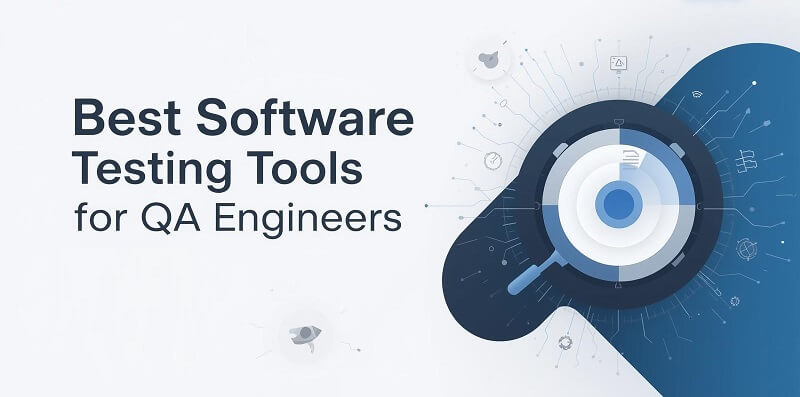Quality Assurance (QA) is now one of the maximum full-size factors of software development nowadays. With businesses freeing applications at a document velocity, trying out tools assist QA engineers in ensuring overall performance, safety, and personal pleasure. By 2025, the QA landscape has considerably modified with new equipment surfacing, automation becoming more prominent, and synthetic intelligence (AI) transforming testing techniques.
Here, we’ll discover the first-class open-source DevOps tools that replace Jenkins and other top software testing tools for QA engineers in 2025. Each tool gives one-on-one strength, from automation and non-stop integration to bug monitoring and utility testing. No matter if you’re just starting out or you’re a seasoned QA pro, this guide is here to help you pick the right tools to boost your work.
Why QA Engineers require powerful testing equipment
Before diving in the list, it is important to understand why these gears matter so much.
- Rapid release cycle: Agile and Devaps have shortened the time of release. Testing tools maintain up with those speedy cycles.
- Automation: Manual checking out alone is now not enough. Tools that automate repetitive duties help QA engineers save time.
- Scalability: Applications now manage hundreds of thousands of users. Tools take a look at overall performance at scale.
- Integration: Test equipment now combines with CI/CD pipelines for easy flows.
AI-in-operated insights: In 2025, equipment patterns, forecasting defects, and taking advantage of AI to accelerate debugging.
Major features for considering in 2025
While considering equipment, QA engineers should look for:
- Cross-platform compatibility: cell, computer, web.
- Automation capabilities: scriptless trying out and script-primarily based checking out.
- CI/CD integration: seamless float with DevOps pipelines.
- Scalability: capacity to test intricate enterprise apps.
- AI capabilities: predictive defect analysis and intelligent test generation.
- Collaboration: simple communication between developers, testers, and managers.
Top Software Testing Tools for QA Engineers in 2025
Here are the top tools QA engineers trust this year.
1. Selenium
Best for: Web software automation
Selenium is the most famous open-supply checking out framework. Its browser automates, and subsequently it is first-rate applicable for net applications. By 2025, it has grown with superior integration and improved guidance for many languages.
Key Features:
- Multiple browser help: Chrome, Firefox, Safari, Edge.
- Supports languages including Java, Python, and C#.
- Integrates with Jenkins, Maven, and Docker.
- Scalable test running with Selenium Grid.
Why QA Engineers Love It: Selenium has flexibility and robust community support, making it the top web automation tool.
2. Katalon Studio
Best for: All-in-one automation testing
Katalon Studio has become a popular free but robust automation platform. Web, API, mobile, and desktop tests are supported.
Key Features:
- Scriptless automation the usage of a drag-and-drop interface.
- Cross-platform checking out.
- Integration with CI/CD pipelines.
- AI-driven take a look at the case era.
Why QA Engineers Love It: It is a stability of ease of use with effective features, making it ideal for newbie and veteran testers alike.
3. TestComplete
Best suited for: Functional and regression tests
TestComplete from SmartBear is a commercial product but provides unparalleled support for GUI tests. Its scriptless nature has gained huge popularity with QA teams in 2025.
Key Features:
- Automates UI tests on desktop, mobile, and web.
- Supports multiple languages.
- Integrated with CI/CD environments.
- AI-based object recognition.
Why QA Engineers Love It: It simplifies complex GUI testing and lightens the test script maintenance load.
4. Cypress
Best for: Front-end testing
Cypress is a rapidly growing open-source test tool that is purposeless for current web apps. Developers and QA engineers benefit from a straight setup and rapid execution.
Key Features:
- Directly operates in the browser.
- Real-time reloads for debugging.
- JavaScript and TypeScript support built-in.
- Parallel execution with CI integration.
Why QA Engineers Love It: Cypress provides immediate feedback, making it ideal for Agile teams developing dynamic front-end applications.
5. Playwright
Best for: End-to-end web testing
Playwright, developed by Microsoft, has developed very quickly as an alternative to Selenium and Cypress. It’s for end-to-end browser testing.
Key Features:
- Supports Chrome, Firefox, and WebKit.
- Is compatible with JavaScript, Python, and .NET.
- Provides parallel testing and headless mode.
- Includes advanced debugging tools.
Why QA Engineers Love It: Playwright offers velocity, dependability, and cross-browser automation in one framework.
6. Appium
Best for: Mobile application testing
Appium is still the gold standard for automating iOS and Android mobile applications. Its open-source framework makes it available to every QA engineer.
Key Features:
- Supports native, hybrid and mobile web apps.
- Cross-platform execution.
- Supports many programming languages.
- The selenium works with the grid.
Why QA Engineers Love It: It enables testers to write once and test multiple times on iOS and Android, avoiding redundant time and effort.
7. JUnit & TestNG
Ideal for: Unit testing
Junit and Testing Java remain fundamental structures for unit testing. They are originally integrated with the CI/CD system and are still light.
Top Features:
- Annotations make it easy to write tests.
- Support for parallel execution.
- Glides smoothly with Maven and Jenkins.
- Extensively supported in enterprise projects.
Why QA Engineers Love It: They are easy but powerful, the backbone of test-driven development.
8. Postman
Best for: API testing
Postman has evolved from a developer tool to an entire API testing tool. By 2025, it encompasses automation, collaboration, and performance testing.
Key Features:
- Easy-to-use interface for API requests.
- Automated testing processes.
- CI/CD pipeline integration.
- GraphQL and REST support.
Why do QA Engineers like it: its use and versatility make postman an indispensable tool for API testing.
9. JMeter
Best for: Load and Performance Tests
Apache Jmeter remains the maximum known open-supply load and overall performance. Take a look at the tool.
Major features:
- Simulates high traffic on web applications.
- Functional behavior and performance testing.
- Plugins and extension support.
- Real-time reporting.
Why QA Engineers Love It: It allows QA teams to detect bottlenecks and validate scalability.
10. QMetry
Best for: Test management
QMetry is an enterprise test management platform for QA teams. It enables testers to plan, run, and track tests.
Key Features:
- Centralized test case repository.
- Automation integration with Selenium and Appium.
- Analytics dashboards.
- Enterprise-grade collaboration.
Why QA Engineers Love It: It provides visibility and traceability throughout testing cycles, simplifying large-scale QA.
11. Ranorex Studio
Best for: Cross-platform testing
Ranorex Studio provides automation assistance for desktop, web and mobile. It is user friendly with a low-code environment.
Key Features:
- Drag-and-drop test creation.
- Cross-platform testing support.
- Integration with Jira, Jenkins, and Git.
- Robust object recognition.
Why QA Engineers Love It: Blends ease of use with enterprise functionality.
12. Bugzilla
Best for: Defect tracking
Bugzilla, although one of the older pieces of equipment, is still a reliable platform for bug trekking and defect management.
Key Features:
- Detailed search and reporting.
- Custom workflows.
- Email notifications of updates.
- Open-source and very customizable.
Why QA Engineers Love It: Offers a solid means of tracking issues between projects.
13. TestRail
Best for: Test case management
Testrail is commonly used for testing case management, execution tracking and progress reporting.
key features:
- User friendly test case organization interface.
- Support for Jira, Github, and CI/CD integration.
- Sophisticated reporting and analysis.
- Supports large teams.
Why QA Engineers Love It: It keeps test management organized and in line, even for complicated projects.
14. Cucumber
Best for: Behavior-pushed improvement (BDD)
Cucumber is used for BDD to permit developers and testers to jot down check cases in undeniable English.
Key Features:
- Gherkin syntax for checking out cases.
- Integrates with Selenium, Appium, and extra.
- Supports Java, Ruby, and JavaScript.
- Powerful collaboration for Agile groups.
Why QA Engineers Love It: It closes the gap among non-technical stakeholders and QA teams.
15. Robot Framework
Best for: General test automation
Robot framework is an open-source automation framework that supports web, API and mobile testing.
key features:
- Keyword-managed test strategy.
- Extensive collection of libraries and plugins.
- The selenium integrates with the epium and API tools.
- Open-sources and community-interacted.
Why QA Engineers like this: its extensibility and flexibility make it perfect for various automation requirements.
Brief comparison of test types
- Web Testing: Selenium, Saru, Playwright.
- Mobile Testing: Appium, Ranorex Studio.
- Performance Test: Jmeter.
- API Testing: Postman.
- Testing Management: Qmetry, Testrail.
- Dosha Tracking: Bagzila.
- BDD: Cucumber.
The Role of AI in QA Testing Tools (2025)
AI has become a central element in contemporary testing:
- Predictive analytics: AI software predicts regions most susceptible to bugs.
- Smart test case generation: Automated generation of test cases by tools.
- Self-healing scripts: Tests dynamically adjust to UI changes.
- Faster defect detection: AI detects root causes much sooner.
How to Select the Correct Tool
- Specify your project requirements: web, mobile, API, or everything.
- Think about team size: tiny teams can work with light-weight tools, while enterprises require management platforms.
- Check for integrations: the tool should integrate smoothly into your CI/CD pipeline.
- Test scalability: choose tools that can manage growth.
- Cost vs. Features: open-supply can be enough, but business wishes premium systems.
Final Thoughts
In 2025, QA engineers have more than ever to draw upon to assure software program fine. Automation to AI-driven insights, all of it continues converting. Tools along with Selenium, Cypress, Playwright, Appium, and Postman continue to be the bedrock, while QMetry and TestRail offer organized control.
The handiest tool in the long run falls on your task type, crew length, and check dreams. With the right aggregate, QA engineers can offer reliable, terrific software that maintains users engaged.









